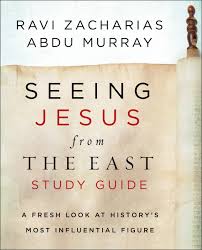When many people think of Christianity, they think of European cathedrals or oak-laden and stained glass-ornamented American churches. Though that’s common to Christianity’s Western trappings, Westerners shouldn’t ignore the gospel’s original Middle Easternness.
I recall a humorous exchange told to me by an American pastor. His church had just begun exploring how it might help foster peace in the Middle East, so he was meeting with Israelis and Arabs. He had the pleasure of meeting a wonderful Palestinian pastor from Bethlehem.
Assuming that the Palestinian pastor had converted to Christianity from Islam, the American asked him, “So I’d love to hear your journey of faith. When did you convert to Christianity?”
With a wry smile, the Palestinian pastor responded, “My family’s Christian heritage goes back to the second century. We’re the originals. When did you guys convert?”
The American pastor was simultaneously amused and embarrassed, having been reminded that olive oil coursed through the early church’s veins.
Kenneth Bailey, who spent so much of his life living in the Middle East, writes, “Arabic-speaking Christianity began on the day of Pentecost when some of those present heard the preaching of Peter in Arabic. In the early centuries, Arabic-speaking Christianity is known to have been widespread in Yemen, Bahrain, Qatar and elsewhere.”
When we forget that Jesus spoke and ministered in the context of a Middle Eastern culture, we can easily misjudge Him by modern Western idioms and customs. Placing Jesus’ words and deeds within an Eastern culture, where community identity and conformity far outweigh individual identity and expression, brings clarity and newfound relevance from which we can benefit today.
But there’s more than just clarity to be gained. While Jesus was thoroughly Middle Eastern, his actions formed the core of later Western values. He bucked tradition and authority to upend the injustices endemic to His culture. Interestingly, those same injustices persist in our day, nearly 2,000 years later and thousands of miles away. Seeing Jesus’ Easternness brings not only fresh clarity; seeing Jesus as the Eastern bridge to Western culture also brings hope as we struggle in the West to address the same issues He dealt with so long ago.
Jesus the Anti-Tribalist
Many critics argue that religion, specifically Middle Eastern monotheism, has led to ignorance, superstition and tribalism that hold back human progress. For these folks, logic, reason and science—presumably championed in the Western Enlightenment—will save us once again. Somehow the irony of this argument has escaped these critics. They decry faith traditions like Christianity as imperialistic tools of Western aggression that keep people in ignorance, but then they want to impose purportedly Western Enlightenment values on the non-Western world. Easterners (yes, even ancient Easterners) regularly employed reason, logic and science to their daily lives without needing Europeans to tell them to do so.
It’s true that Easterners have a story-driven, circuitous way of applying logic, but they apply it with the same force as anyone else. To say Westerners have a lock on logic, truth and discovery is the height of arrogance.
“All the intelligent people were not born in the 20th century,” writes Bailey. Describing the timeless wisdom and ingenious prose in the Bible, he says, “When we observe these sophisticated, thoughtful and artistically balanced rhetorical styles, we form a high opinion of their authors.”
The implied dichotomy between Western Enlightenment and Eastern religiosity leads to an “us versus them” tribalism, which atheistic champions of Enlightenment-age values such as Steven Pinker want to end. That’s a further irony—pitting Western values against Eastern tribalism is, well, tribalistic.
We should be especially sensitive to this kind of tribalism in our day when everything is so polarized. Every political event is charged with animosity toward “the other side.” Free speech is violently stifled by those claiming to be freedom’s champions. It’s easy to label someone a “hater” rather than debate ideas. Judicial confirmation hearings have become tribalized circuses.
Jesus spoke and acted in no less of a tribal culture. The Middle East of the first century was divided along racial and ethnic lines. It was also strongly divided along gender lines. Those of different religious bents were often at odds with each other. And politics was an ever-pervasive source of division and derision. In other words, Jesus’ culture was curiously similar to our own.
That’s why Jesus’ way of turning situations on their heads can help us today. His ancient wisdom surprises us again and again in how contemporary it actually is. Marcello Pera, the atheist philosopher and former Italian politician, has argued powerfully that Western love of liberty, equality and brotherhood simply wouldn’t exist without the Christian message.
Jesus, Race and Ethnicity
As I think about how Jesus addressed racial and ethnic tensions similar to those we deal with today, His encounter with a Gentile (non-Jewish) woman leaps to mind (Matt. 15:21–28). In fact, she wasn’t just a Gentile; she was a Canaanite—the very people who had committed such atrocities against the Hebrews that God commanded their very way of life to be wiped out (Deut. 7:20, Josh. 11, Judg. 1:2).
The context of this encounter is key. Jesus went to Tyre and Sidon, which today are in modern Lebanon. The Canaanite woman called Jesus the “Son of David” (Matt. 15:22)—a specifically Jewish way of referring to the Messiah—and asked Him to help her demon-oppressed daughter. The cultural and religious norms of the day called for Jews to ignore Gentile pleas. In fact, Jesus’ disciples begged Him to send her away (Matt. 15:23). Jesus used the situation not only to help the woman, but also to teach people—especially His own disciples—to overcome their prejudices.
Merely saying something like “God loves everybody, regardless of ethnicity” wouldn’t have stuck in the Middle Eastern mind. The Middle East has always been so awash in idioms and platitudes that such a statement would have been diluted. Middle Easterners love clever banter, however, and that’s what sticks. So Jesus engaged the woman in exactly that.
At first, Jesus seemed to rebuff her plea with silence, seeming to conform to cultural expectations. He then built on this by surfacing the ethnic division between her and him. “I was sent only to the lost sheep of Israel,” he told her (Matt. 15:24). But she was undaunted, persisting even to the point of calling Jesus “Lord.” Jesus had a point to make to both Jews and Canaanites who gathered around to watch the spectacle. With a sarcastic tone meant to ferret out the prejudices of the very people listening, Jesus aped the Jewish-centered response the crowd expected: “It is not right to take the children’s bread and toss it to the dogs” (Matt. 15:26b, ESV). Savvy enough to see where Jesus was heading, the woman quipped back, “Yes, Lord, yet even the dogs eat the crumbs that fall from their masters’ table” (Matt. 15:27).
“O woman, great is your faith!” He exclaimed. “Be it done for you as you desire” (Matt. 15:28b).
Jesus healed her daughter and honored the faith of the Canaanite woman, whose motherly love gave her the courage to breach ethnic and religious barriers. He involved her in the lesson to the crowd. He wasn’t interested in only removing the demon that oppressed the woman’s daughter, but also in exorcising the demon of racism that had oppressed Israel, Canaan and the entire region.
This wasn’t an isolated incident. At another time, a Roman centurion asked Jesus to heal His servant and Jesus obliged. Again Jesus praised the faith of a non-Jew: “I tell you, not even in Israel have I found such faith” (Luke 7:9b).
In these two examples (among several others), Jesus highlighted the faith of non-Jews before those mired in the ethnocentric religiosity around Him. The master of paradox, He upended tradition to effectuate change.
In stark contrast to what we see happening today, Jesus wasn’t interested in catering to “His base” or “His side.” He wanted to rectify social wrongs while teaching people. He coupled His message with action. His words and his deeds healed cultural divides and individual people. Perhaps we in the modern West could learn something from this timeless Easterner.
Jesus and Gender Equality
In the very early days of my ministry, I walked through the halls of a university building after giving a nerve-racking talk. My hosts were taking me to a display put up by the Secular Student Alliance. It was quite fascinating. Books like Sam Harris’ The End of Faith and Richard Dawkins’ The God Delusion were shown, with a plaque next to them that read, “TRUTH” in bold lettering. The Bible was also on display, but with a plaque that read, “FALSE” next to it. The display included Bible passages taken out of context that seemed to promote misogyny, raping of women and treating them like property. The display not only swam in the Western cultural narrative that Christianity is a white, male religion that oppresses women, but it was also trying to hurry that current along.
It was an appallingly superficial treatment of the Bible—a terrible example of quote mining to fit a predefined narrative. Of course, the Bible has been misused by some men to justify treating women as second-class citizens. I daresay, however, that the Bible properly understood contains not only a few gems of passages and stories about the equality of women, but full treasure troves of teachings, laws and accounts about women’s status as those who bear God’s image equally to men. Exploring that trove will help us swim against the cultural stream.
In the Christian tradition, the single most important event in human history is Jesus’ Resurrection. The Resurrection proved Jesus right in his claim that humanity is sinfully separated from God, that He Himself could bridge the chasm between God and humanity by paying the debt we deserved to pay, and that He had power over death—humanity’s seemingly invincible enemy. The Bible records that the first people to lay eyes on Jesus’ resurrected body were women. This isn’t a mere scrap of narrative detail. In the first-century Middle East, a woman’s testimony was worth half that of a man, if it was worth anything at all. Yet the gospel message that Jesus had risen from the dead was meant to take root in that very context.
This aspect of the Bible’s account is of utmost importance for at least two reasons. First, it lends credibility to the Resurrection narrative. Consider this: If the Gospel writers (or the early church) had invented Jesus’ Resurrection, would they have made women the first eyewitnesses to the fact? No, they would have made men the heroes and the witnesses. Choosing women as the first eyewitnesses would have been laughable to the Middle Eastern mind, making the account less acceptable. The Gospel authors would have had no incentive to write that account—unless that’s how it actually happened.
Second, and just as important, Jesus seemed to be making a statement about the character, quality and value of women by honoring them as the primary witnesses to His crowning miracle. The Middle Eastern mindset of that day discounted their value. I daresay Jesus’ own disciples likely did that same thing before the Resurrection. Yet Jesus chose women not only to be the first to see Him risen, but also to tell the men what had happened. How poetic! Jesus used the misogyny of his day to simultaneously give credible evidence of His Resurrection and to turn the tables on His culture’s devaluing of women.
So much more could be said. There are concrete examples throughout the pages of Holy Writ demonstrating gender equality:
—The Bible counts women among the prophets who spoke for God, specifically identifying five and alluding to many more not specifically listed (Ex. 15:20, Judg. 4-5, 2 Kings 22:14, Neh. 6:14, Isa. 8:3, Luke 2:36, Acts 21:9).
—God elevated Deborah to the position of “judge,” a leader with authority over the most highly placed men in Israel (Judg. 4-5).
—God heard the plea of Hagar and promised to provide for her and her son as they despaired in the desert (Gen. 16:7-14).
—When a prostitute showed the kind of integrity needed to advance God’s plan, she was saved from judgment and is specifically named among the heroes of faith in the book of Hebrews (Heb. 11:31).
—When King Josiah found the book of the Law, he directed a woman named Huldah to verify it (2 Kings 22:14).
—Books of the Bible such as Ruth and Esther bear the names of women of courage and integrity.
The Bible’s recognition of the dignity of women has echoed down through the centuries. The ideal of feminine dignity, so elusive for us even today, has been secured by the Middle Eastern man from Nazareth. His words expressed dignity for women. His actions imparted status to those whom society tried to suppress. As male Easterners beheld this Jesus, they were challenged and taught to overcome their prejudices. As Eastern women spent time with him, they rediscovered the original dignity they had been conditioned to forget. As we in the West look on Jesus now, perhaps we can move forward and better grasp a future laced with equality of race and gender by peering through time and seeing Jesus from the East.
How amazing that Jesus’ Easternness is what so beautifully addresses Western issues today. When His actions and words are understood within an Eastern context, Western eyes can behold Jesus’ Easternness as novel, yet timeless. At the same time, Easterners who have been told Christianity is a tool of Western imperialism can recapture Jesus as one of them and thus behold him afresh.
His Easternness confounds our narratives, yet His ability to address the very issues that plague Western culture make him timelessly familiar to us all. He has influenced ancients and moderns. He has influenced the East and the West. We simply must give him a fresh look. {eoa}
This article is an excerpt from Seeing Jesus From the East, written by Ravi Zacharias and Abdu Murray. The book is available now on Amazon.
 Abdu Murray (JD, University of Michigan) is Senior Vice President of RZIM and a regular speaker at churches, college campuses, and business and government gatherings. He hosts the podcast The Defense Rests. A scholar in residence at the Josh McDowell Institute of Oklahoma Wesleyan University, he is the author of many articles and three books, including his latest, Seeing Jesus from the East.
Abdu Murray (JD, University of Michigan) is Senior Vice President of RZIM and a regular speaker at churches, college campuses, and business and government gatherings. He hosts the podcast The Defense Rests. A scholar in residence at the Josh McDowell Institute of Oklahoma Wesleyan University, he is the author of many articles and three books, including his latest, Seeing Jesus from the East.
See an error in this article?
To contact us or to submit an article






















